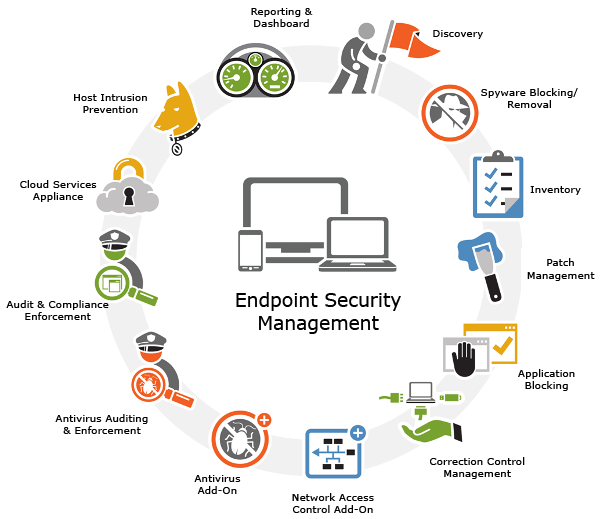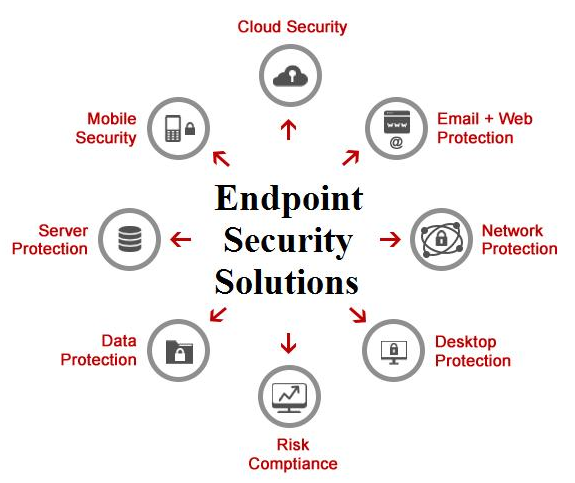This article was published as a part of the Data Science Blogathon.
Introduction
Historically, most organizations used conventional security products such as firewalls, VPNs, endpoint management solutions, and antivirus programs to protect sensitive information, prevent unauthorized access to critical applications and I.T. systems, and protect against malware and other vulnerabilities.
.jpg)
However, businesses are increasingly adopting mobile applications and cloud services, disrupting the once well-defined perimeter of the enterprise network. Cyber attackers are becoming more sophisticated and are increasingly able to evade traditional security measures. Many enterprises are now taking an in-depth approach to endpoint protection and implementing a wider range of security controls to protect against a wider range of threats.
Endpoint Security
Endpoint security is protecting corporate networks from threats from local or remote devices. An endpoint is a device that provides an entry point to corporate assets and applications and presents a potential cybersecurity vulnerability.
An in-depth Approach to Endpoint Security
Originally designed by the U.S. National Security Agency, the defense-in-depth approach uses multiple layers of security to close gaps, reduce attack surfaces, and limit threats.

A complete endpoint security-in-depth strategy includes five key endpoint security and management measures:
- Antivirus and next-generation antivirus solutions prevent, detect, and remove various forms of malware. Next-Generation Antivirus (NGAV) solutions use analytics and machine learning to defend against cutting-edge attacks such as ransomware and advanced phishing that can escape conventional antivirus programs.
- Patching the operating system to mitigate common vulnerabilities and threats (CVEs). All major operating system manufacturers routinely release software updates to address known security issues. Enterprise I.T. and security organizations can reduce risks by implementing automated O.S. updating and other systems and procedures to ensure that all corporate computers, servers, and mobile devices are running the latest version of the operating system.
- Application patching Organizations can improve their security by ensuring that all enterprise desktop, server, and mobile applications are up-to-date.
- Permission management grants users and processes the minimum permissions they need to perform required tasks. Also known as the principle of least privilege (POLP), privilege management removes local administrator rights on servers and P.C.s. It limits access permissions to authorized users and applications to reduce risk.
Why should the Endpoint be Secure?
Productive endpoint security is a must for modern businesses – locking every door in your corporate house is no longer a matter of choice. Data is the fuel of business, and protecting it is paramount to an organization’s success.
With the shift to mobility, security must now occur at all points within the network. Centralized security systems have proven ineffective in today’s dispersed landscape. Jose-Miguel Maldonado, Vice President of Business Ops & Security at Rubica, explains: “People are outside the corporate security fabric and today’s attacks are extremely sophisticated. Traditional solutions such as on-premise firewalls and antivirus are simply not enough anymore.”
On-point Security
This enables based on securing all network endpoints from a solution hosted and managed on internal servers. The user bears all costs – this includes cooling, staff, space, and electricity. On-point software usually requires a large initial investment and can require lengthy installation. For these reasons, they may not be the best choice for organizations on a tight budget looking for a faster solution.
Cloud-based Endpoint Security
This option includes securing all network endpoints from a solution hosted and managed on the vendor’s cloud. Often referred to as “endpoint protection,” this solution provides a cost-effective and agile option that can be deployed in minutes. Cloud solutions offer several benefits, starting with access to vendor databases and monitoring that provides a quick response to threats. In addition, for a reasonable monthly fee, users get automatic data backup, faster repairs even for remote devices, and remote system control.

Types of Endpoint Security
Endpoint security uses specific procedures to block threats and secure your network.
- Endpoint Encryption: Involves encoding and scrambling data, making it indecipherable without a key. Encryption is the last and perhaps most important layer of security as it protects data even if the wrong person has it.
- Forensic Analysis: Works in parallel with EDR by monitoring all endpoint activity and creating a digital trail of all incidents. All information and evidence related to the attack – what happened, who is responsible, and the resulting consequences – is collected and analyzed to prevent future incidents.
- IoT Security: Many IoT devices lack adequate security after installation. Start by installing an EDR system to find vulnerabilities, manage and monitor. Be sure to remove legacy devices, install next-generation solutions, monitor access by all apps and devices, encrypt communications, and segment your network to isolate problems.
- Email Gateways: Email is the most common way criminals spread spam; that’s why email software is not safe today. Safe emails continue through the system while potential threats go to quarantine.
- Quarantine Protection: This is separating dangerous files to prevent damage to devices and networks. Rapid isolation of dangerous files is essential for endpoint security, and quarantine also allows valuable files to be cleaned, not thrown away.
Demonstrating Sufficient Endpoint Security
If there’s one thing more important than securing your endpoints, it’s evidence. Reporting your organization’s ability to control risk and protect sensitive data offers many benefits, from avoiding regulatory fines to maintaining an attractive supplier reputation.

SOC 2 reports are unique to every organization, with fluid requirements and custom controls. Your organization can set its criteria but must ensure that controls are in place to meet the requirements and then effectively document the auditor’s success – not always an easy task. Other related content: SOC 2 compliance: What you need to know and do. Hyper proof’s SOC framework supports endpoint security with Hyper proof’s operational compliance software.
Endpoint Security is Critical to your Business
In today’s mobile world, security is evolving rapidly – endpoints now form the new perimeter, and organizations need to secure their data across various networks. As organizations grow, so do their endpoint, and vulnerability security is a must for all businesses, regardless of size or status.
Smart organizations of all sizes will strengthen the new perimeter and protect every device as if it were the key to their entire house with robust endpoint solutions. They’ll avoid the financial and reputational blow of costly breaches—and their CISOs will sleep better at night knowing their endpoint network is secure.
Benefits of Endpoint Privilege Management
Endpoint privilege management solutions help strengthen security and reduce risk by removing unnecessary local administrator privileges from endpoint devices and limiting malicious applications and other threats on the endpoint. An essential component of an endpoint security-in-depth strategy, an endpoint privilege management solution provides a critical layer of protection when an attack evades traditional perimeter and endpoint security controls.
Endpoint authorization management solutions enable enterprise I.T. operations, security, and compliance teams to:
- Provide least privilege access for end devices and strengthen security.
- Secure and rotate local administrator passwords to prevent credential theft.
- Prevent end users from installing unapproved applications and limit exposure.
- Run unknown apps in restricted mode and prevent corporate assets or confidential data access.
- Protect against, block, and contain malware and endpoint attacks, prevent lateral movement and spread of malware, and reduce risk.
- Automatically escalate permissions base, increase user productivity while reducing I.T. burden.
Conclusion
Let’s see What we have Learned today; Cyber attackers are becoming more sophisticated and are increasingly able to evade traditional security measures. Many enterprises are now taking an in-depth approach to endpoint protection and implementing a wider range of security controls to protect against a wider range of threats.
- Productive endpoint security is a must for modern businesses – locking every door in your corporate house is no longer a matter of choice. Data is the lifeblood of business, and protecting it is paramount to an organization’s success.
- SOC 2 reports are unique to each organization, with fluid requirements and custom controls. Your organization can set its criteria but must ensure that controls are in place to meet the requirements and then effectively document the auditor’s success – not always an easy task. Other related content: SOC 2 compliance:
- Endpoints now form the new perimeter, and organizations must protect their data across networks. As organizations grow, so do their vulnerabilities, and endpoint security is a must for all businesses, regardless of size or status. Jose-Miguel Maldonado emphasizes this point: “Whether you’re a small or large business today, you need to spend time and effort securing your business with a strong endpoint security solution.”
The media shown in this article is not owned by Analytics Vidhya and is used at the Author’s discretion.







